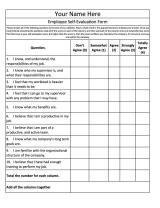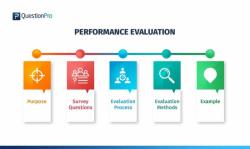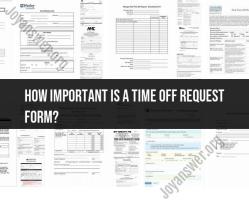How to rate job performance?
Evaluating job performance is a critical part of the performance management process in organizations. Effective performance evaluation provides employees with feedback on their work, helps identify areas for improvement, and supports decision-making related to promotions, raises, and development opportunities. Here are some best practices and guidelines for rating job performance:
Establish Clear Performance Expectations:
- Before you can rate job performance, you need to have clear performance expectations in place. These expectations should be communicated to employees through job descriptions, performance standards, and goals.
Use a Standardized Rating System:
- Develop a standardized rating system or performance appraisal form that outlines the criteria for evaluation. This form should include specific competencies, behaviors, or goals that align with the employee's role and responsibilities.
Set SMART Goals:
- Ensure that performance goals are SMART (Specific, Measurable, Achievable, Relevant, Time-bound). SMART goals provide a clear framework for evaluation.
Collect Data and Evidence:
- Gather objective data and evidence to support your performance ratings. This may include quantitative metrics, qualitative feedback from colleagues or customers, and examples of the employee's work.
Regular Feedback:
- Provide ongoing feedback to employees throughout the evaluation period. Don't wait until the formal review to discuss performance issues or accomplishments.
Use Multiple Sources of Feedback:
- Incorporate feedback from various sources, including self-assessments, peer reviews, supervisor evaluations, and customer feedback. Multiple perspectives provide a more comprehensive view of performance.
Avoid Recency Bias:
- Avoid the tendency to focus solely on recent events or behaviors when rating performance. Consider the employee's performance over the entire evaluation period.
Be Objective and Fair:
- Base your ratings on observable and measurable behaviors and results rather than personal opinions or biases. Be fair and consistent in your evaluations.
Differentiate Performance Levels:
- Use a rating scale that allows for differentiation between different levels of performance (e.g., exceeds expectations, meets expectations, needs improvement). Avoid inflation of ratings.
Document Performance:
- Maintain thorough records of employee performance throughout the evaluation period. Document specific examples, achievements, and areas for improvement.
Provide Constructive Feedback:
- When rating performance, offer constructive feedback that highlights strengths and suggests areas for growth. Be specific in your feedback and offer actionable suggestions for improvement.
Set Goals for Improvement:
- If an employee's performance is below expectations, work with them to set clear goals and a development plan to help them improve.
Conduct Regular Performance Reviews:
- Schedule regular performance review meetings with employees. Use these meetings to discuss ratings, provide feedback, and set goals for the future.
Include Employee Self-Assessment:
- Allow employees to complete a self-assessment as part of the evaluation process. This encourages self-reflection and can provide valuable insights.
Training and Calibration:
- Train managers and evaluators on the performance evaluation process to ensure consistency and fairness in ratings. Conduct calibration sessions to ensure that ratings align across the organization.
Consider the Whole Employee:
- Take into account not only job-specific performance but also factors such as teamwork, communication skills, and alignment with the organization's values and culture.
Legal Compliance:
- Ensure that your performance evaluation process complies with relevant employment laws and regulations to avoid legal issues.
Follow Up:
- After the performance evaluation, follow up with employees to track progress, provide ongoing support, and make adjustments as needed.
Remember that the goal of performance evaluation is to support employee development and organizational improvement. It should be a two-way conversation where employees have the opportunity to share their perspectives and goals as well. Effective performance evaluation is an ongoing process, not just an annual event, and should contribute to a culture of continuous improvement and growth within the organization.
Effective Techniques for Evaluating Job Performance
There are many different techniques that can be used to evaluate job performance. Some of the most effective techniques include:
- Setting clear goals and metrics: Before evaluating an employee's performance, it is important to set clear goals and metrics for the employee to achieve. This will help to ensure that the evaluation is fair and objective.
- Using multiple sources of information: When evaluating an employee's performance, it is important to use multiple sources of information. This may include self-assessments, peer reviews, supervisor evaluations, and customer feedback.
- Focusing on the employee's behavior: When evaluating an employee's performance, it is important to focus on the employee's behavior, not their personality. This will help to ensure that the evaluation is focused on the employee's job performance.
- Providing constructive feedback: When providing feedback to an employee, it is important to be constructive. This means focusing on the employee's strengths and areas for improvement, and offering specific suggestions for how the employee can improve their performance.
Setting Clear Goals and Metrics for Performance Reviews
When setting goals and metrics for performance reviews, it is important to make sure that they are specific, measurable, achievable, relevant, and time-bound.
- Specific: Goals should be specific and well-defined.
- Measurable: Goals should be measurable so that progress can be tracked over time.
- Achievable: Goals should be achievable but challenging.
- Relevant: Goals should be relevant to the employee's job and the company's goals.
- Time-bound: Goals should have a specific deadline.
For example, a goal for a sales representative might be to increase sales by 10% in the next quarter. This goal is specific, measurable, achievable, relevant, and time-bound.
Providing Performance Feedback and Documentation
It is important to provide employees with regular feedback on their performance. This feedback should be specific, timely, and constructive.
Feedback can be provided in a variety of ways, such as during one-on-one meetings, team meetings, or in writing. It is important to choose a method of feedback that is comfortable for both the employee and the manager.
It is also important to document employee performance. This documentation can be used to support performance reviews, disciplinary action, or other HR processes.
Performance documentation should be specific, objective, and accurate. It should also be kept confidential.
By following these tips, employers can use effective techniques to evaluate job performance and provide employees with the feedback and documentation they need to succeed.












